If you are looking for the best aquarium plants for angelfish then you are at the right place.
In this article, I’m going to show you the plants that are a good fit for angelfish.
I have shortlisted these plants on the basis of angelfish needs, compatibility, and their natural habitat.
Table of Contents
Here’s a Quick Table Containing the Best Aquarium Plants for Angelfish Tank
| Plant Name | Care level | Check latest price on Amazon |
|---|---|---|
| Amazon sword | Easy | Click here |
| Java Fern | Easy | Click here |
| Jungle Vallisneria | Moderate | Click here |
| Anubias | Easy | Click here |
| Hornwort | Easy | Click here |
| Water Wisteria | Easy | Click here |
| Water Sprite | Easy | Click here |
| Red tiger lotus | Easy | Click here |
| Asian ambulia | Moderate | NA |
| Water Lettuce | Moderate | Click here |
| Dwarf Sagittaria | Easy | Click here |
| Java moss | Easy | Click here |
| Temple plant | Easy | Click here |
| Cryptocoryne wendtii | Easy | Click here |
| Lace plant | Moderate | Click here |
| Moneywort | Moderate | Click here |
| Corkscrew Vallisneria | Easy | Click here |
Do angelfish need live plants?
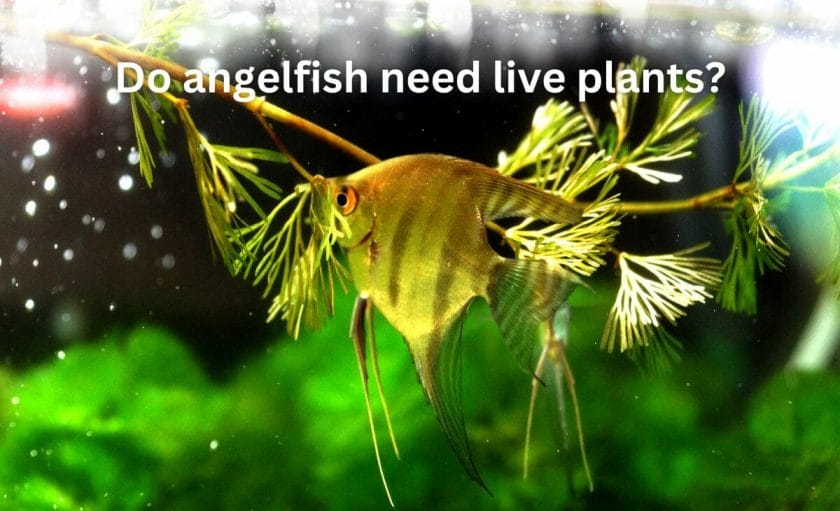
It is not absolutely necessary to keep live plants in your angelfish tank.
But you should put some plants in an angelfish tank so that they can lay their eggs on them. It will also provide hiding places so they will not be stressed out all the time.
This can be achieved even with fake aquarium plants instead of live plants.
But there are so many benefits of keeping live aquarium plants in the tank rather than fake plants.
Live plants help to oxygenate the tank. They also help to filter the tank. Also, they help to control the ammonia levels in the tank.
Besides, live plants look much better than fake plants if you take good care of it.
So, in a nutshell, it is not absolutely necessary to keep plants in an angelfish tank but I highly recommend you keep them.
What live plants do angelfish like?
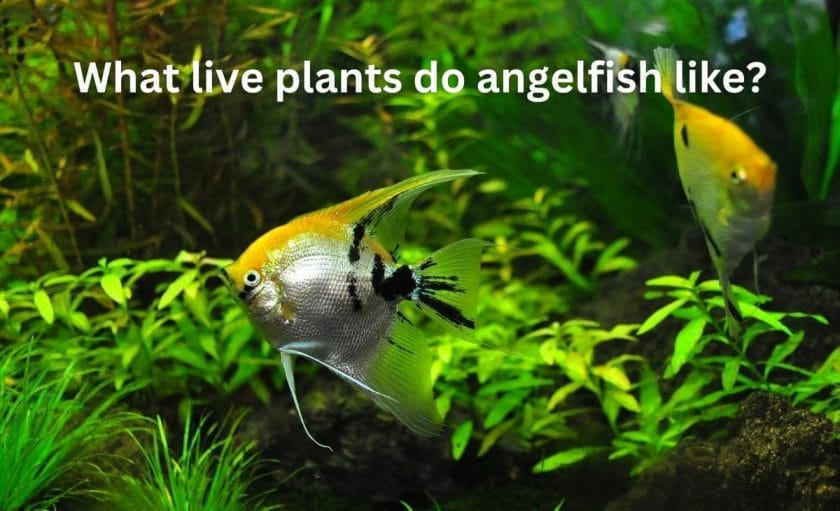
In its natural habitat angelfish are usually found in the flooded forests.
Their natural habitat contains a lot of tall-growing plants and angelfish like to swim through them.
The plants also provide a lot of hiding places for Angelfish.
As angelfish like to lay their eggs on vertical surfaces, usually, they lay their eggs on the leaves of aquarium plants.
Angelfish usually like plants that are tall growing and have wide, long leaves.
They like a densely planted aquarium which provides them with a lot of hiding places.
What kind of plants can you put in a fish tank?
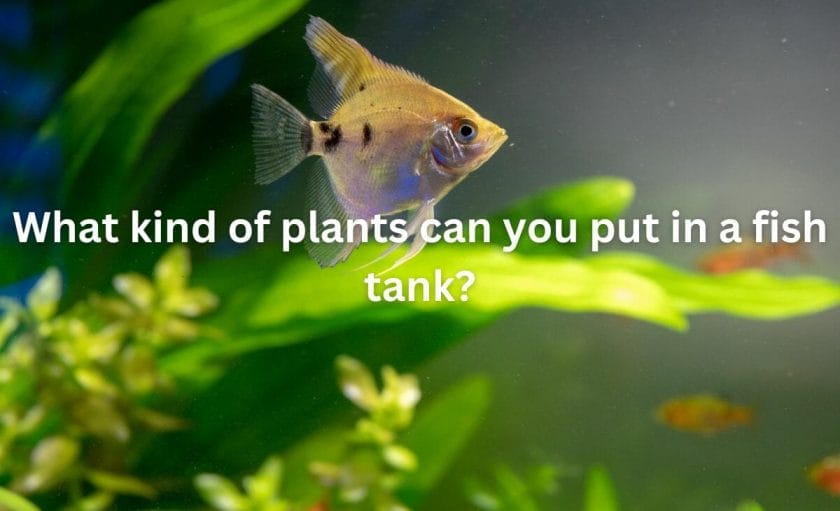
There are several types of plants you can keep in your fish tank
Floating aquarium plants
As the name suggests, these are the floating aquarium plants that float on the surface of the water of the aquarium.
These plants are great to create shading areas in your aquarium.
Besides, they also help to lower the temperature in the aquarium.
They also provide a lot of hiding places for the fry.
Carpet aquarium plants
Carpet aquarium plants, as the name suggests, provide a nice carpeting effect on the surface of the substrate of your aquarium.
These are the short plants that usually grow very rapidly and very close to each other, creating a nice carpeting effect.
Background midground aquarium plants
Usually, these are the tall-growing aquarium plants that you can keep in the background or in the middle ground of your aquarium.
These kinds of plants are especially good for your angelfish because they usually have wide pointed leaves on which angelfish can lay their eggs.
And it also provides a lot of hiding places for you are angelfish.
17 Best Background Plants for Aquarium
Best Aquarium Plants For Angelfish
1. Amazon Sword
See more images at Amazon here
| PARAMETERS | VALUES |
|---|---|
| PLANT | Amazon sword |
| SCIENTIFIC NAME | Echinodorus grisebachii |
| FAMILY | Alismataceae |
| CARE LEVEL | Easy |
| LIGHT REQUIREMENT | Moderate |
| GROWTH RATE | Fast |
| TEMPERATURE | 60.8-82.4°F |
| pH | 6.5-7.5 pH |
| HARDNESS | 8-15°dH |
| PLACEMENT | Background |
| MAXIMUM SIZE | 16 Inches |
| MINIMUM TANK SIZE | 10 Gallons |
Amazon sword is one of the most popular plants in the aquarium hobby.
It is also one of the few flowering aquarium plants.
This is a tall-growing stem plant that can grow as tall as 16 inches.
This plant has white long leaves and it provides a lot of hiding places which makes it an ideal plant for an angelfish aquarium.
Besides, it is a fast growing plant and it is also very easy to care for which makes it an ideal choice for beginners.
How much light does Amazon sword require?
Amazon sword does well under low to moderate lighting conditions.
Ideally, you should provide it at least two watts of light per gallon.
What’s the best place to keep it in an aquarium?
Amazon sword can grow very large and wide so ideally, you should keep it in the center of your aquarium.
It is a fast and tall growing stem plant that can grow as tall as 16 inches, so you can also keep it in the background of your aquarium.
You can also keep it in the middle ground of your aquarium if you are going for the jungle effect.
Substrate requirements
You can use any substrate for planting Amazon sword in your aquarium.
In its natural habitat, Amazon sword usually grows in a sand substrate.
So ideally, you should plant it in a sand substrate but it is not absolutely necessary.
When it comes to the substrate for Amazon sword, one thing you should keep in mind is that the substrate should be at least 2.5 inches thick.
This will allow it to form a strong root system in the substrate.
Fertilization requirements
Amazon sword is a pretty hardy plant and it can get nutrients from fish food and freshwater.
So it doesn’t necessarily require additional fertilizers.
But if you provide additional fertilizers then it will definitely benefit from it and grow faster and denser.
Amazon sword is a heavy root feeder plant so ideally you should supplement it with fertilizers in the form of root tab.
But it can also draw nutrients through its leaves, so you can also use liquid fertilizers for this plant.
Ideal water parameters
Amazon sword can tolerate a wide range of water parameters.
It can tolerate temperatures as low as 60 degrees Fahrenheit to up to 82 degrees Fahrenheit so you can easily keep it in a coldwater aquarium.
Its pH tolerance range is between 6.5 to 7.5 and the hardness tolerance range is between 8 to 15° DH.
Check the latest price of this plant at Amazon here
2. Java Fern
See more images at Amazon here
| PARAMETERS | VALUES |
|---|---|
| PLANT | Java Fern |
| COMMON NAMES | Java Fern |
| SCIENTIFIC NAME | Microsorum pteropus |
| FAMILY | Polypodiaceae |
| CARE LEVEL | Easy |
| LIGHT REQUIREMENT | Low to Moderate |
| GROWTH RATE | Low to Moderate |
| TEMPERATURE | 68-82oF |
| pH | 6.0-7.5 |
| HARDNESS | 60-160 ppm |
| PLACEMENT | Mid to Background |
| MAXIMUM SIZE | 13.5 inches |
| MINIMUM TANK SIZE | 5 Gallons |
Java fern is another popular plant in the aquarium hobby. It is also one of the best plants for Tetras and Guppies.
The best part about Java fern is that it is very easy to care for and also it is very cheap.
Java fern is a tall-growing plant with long leaves so it is a good choice for an angelfish tank.
Also, Java fern is compatible with most of the aquarium fish which makes it an ideal choice for the community tanks.
How much light does Java fern require?
Java fern is not very demanding when it comes to light.
It can do well in almost any lighting condition.
Ideally, you should keep it under moderate lighting conditions and provide it with at least 1.5-2 watts of light per gallon.
What’s the best place to keep it in an aquarium?
Java fern is a slow-growing plant but this plant can grow pretty large. So ideally, you should keep it in the middle ground or background of your aquarium.
You can also keep it in the foreground of your aquarium if you are going for the jungle look.
Ideal water parameters
Java fern can tolerate a decent range of water parameters.
That being said, the ideal temperature range for this plant is between 60-82 degrees Fahrenheit.
Its pH tolerance range is between 6 to 7.5 and the hardness tolerance range is between 3-8 KH.
Substrate requirements
Java fern doesn’t really require any substrate to keep it in the aquarium.
But if you want to plant it in a substrate then you can use any substrate of your choice because it doesn’t draw nutrients from the substrate.
You can also just let it float in your aquarium but eventually, it will find a place in your aquarium and get attached through its rhizomes.
Fertilization requirements
The nutrients that it can get from the leftover fish food and fish poop are sufficient for this plant.
But if you want faster growth then you can always supplement it with fertilizers.
As Java fern is a water column feeder plant i.e. it draws nutrients through its leaves and not through its rhizomes.
So you should supplement fertilizer in the form of liquid fertilizers.
You should add these fertilizers after the weekly water change.
Check the latest price of this plant at Amazon here
3. Jungle Vallisneria
See more images at Amazon here
| PARAMETERS | VALUES |
|---|---|
| PLANT | Jungle Vallisneria |
| COMMON NAMES | Jungle Val, water celery, tape grass or eelgrass |
| SCIENTIFIC NAME | Vallisneria Americana |
| FAMILY | Hydrocharitaceae |
| CARE LEVEL | Intermediate |
| LIGHT REQUIREMENT | Medium |
| GROWTH RATE | Fast |
| TEMPERATURE | 65° – 85° F |
| pH | 6.8 – 8.0 |
| HARDNESS | Moderately Hard to Very Hard |
| PLACEMENT | Background |
| MAXIMUM SIZE | 6 feet (2 meters) |
| MINIMUM TANK SIZE | 10 gallon |
Jungle Vallisneria is one of the hardy aquarium plants in the hobby.
This plant can tolerate a wide range of water parameters which makes it an ideal choice for beginners.
The natural habitat of angelfish usually contains Vallisneria so it is one of the best plants you can keep in an angelfish tank.
Besides, it is also one of the best oxygenating plants.
How much light does jungle Vallisneria require?
Jungle Vallisneria is not very demanding when it comes to light.
You can keep it in almost any lighting condition and it will do just fine.
You can easily keep it in a low-lighting condition.
But if you want faster growth then you should keep it under bright lighting conditions.
What’s the best place to keep Jungle Vallisneria in the tank?
As Jungle Vallisneria is a tall-growing plant that can grow as tall as 6 feet so ideally you should keep it in the background of your aquarium.
You can also keep it in the middle ground of your aquarium if you are going for the jungle effect.
Ideal water parameters
As mentioned earlier, Jungle Vallisneria can tolerate a wide range of water parameters.
That being said, the ideal temperature range for this plant is between 65-85 degrees Fahrenheit.
Its pH tolerance range is between 6.8-8 and it does well in moderately hard to very hard water.
Substrate requirements
You can use any substrate for planting Jungle Vallisneria in your aquarium.
You can use sand or gravel substrate for this plant.
If you plant it in a nutrient-rich substrate then it will definitely benefit from it and grow faster.
Fertilization requirements
Jungle Vallisneria is a pretty hardy plant.
The nutrients that it can get from fish poop and leftover food are sufficient for its proper growth.
But if you want to encourage faster growth then you can supplement it with some additional fertilizers.
You can use both liquid fertilizers as well as root tabs for this plant.
Check the latest price of this plant at Amazon here
4. Anubias
See more images at Amazon here
| PARAMETERS | VALUES |
|---|---|
| PLANT | Anubias |
| COMMON NAMES | Anubias |
| SCIENTIFIC NAME | Anubias |
| FAMILY | Araceae |
| CARE LEVEL | Easy |
| LIGHT REQUIREMENT | Low-Moderate |
| GROWTH RATE | Slow |
| TEMPERATURE | 72-82°F |
| pH | 6.5 – 7.8 |
| HARDNESS | 60- 160 ppm |
| PLACEMENT | Mid-background |
| MAXIMUM SIZE | 11+ Inches |
| MINIMUM TANK SIZE | 5 Gallons |
| PROPAGATION | Rhizome Division |
Anubias is another popular plant in the aquarium hobby. It is also one of the best plants for Shrimps.
This is a slow-growing plant so you don’t have to trim it or look after it because it is not going to take over your aquarium.
This plant is also very hardy so it is a good choice for beginners.
Besides, this plant is a bit expensive but as I just mentioned, it is hardy so it will not die very easily.
Unlike other plants in this list, this is not a tall plant. But you can easily attach it to driftwood which helps to emulate the natural habitat of angelfish and make it feel comfortable and safe.
How much light does Anubias require?
Anubias is not very demanding when it comes to light.
It can easily do well under low-lighting conditions.
If you want faster growth then you can also keep it under high lighting conditions.
But keeping it under high lighting conditions can also cause algae growth on the leaves of this plant.
So ideally, you should keep it under low to moderate lighting conditions. And provide it light anywhere between 2-3 watts per gallon.
What’s the best place to keep it in the tank?
Anubias is a slow-growing short aquarium plant that makes it an ideal plant to keep in the foreground of your aquarium.
If you have a nano tank then you can also keep it in the middle ground of your aquarium.
Ideal water parameters
The ideal temperature range for Anubias is between 72-82 degrees Fahrenheit.
Its pH tolerance range is between 6.5 to 7.8 and the hardness tolerance range is between 3-8 KH.
Substrate requirements
Anubias doesn’t have any real roots, instead, it has rhizomes.
So it doesn’t really draw the essential nutrients from the substrate.
So you can use any substitute for planting it in your aquarium.
You can also tie it to any ornament in your tank like driftwood or rock and then put it inside your aquarium.
Fertilization requirements
For optimum growth of Anubias, you should regularly supplement fertilizers.
As it draws most of its nutrients through the water column, you should supplement liquid fertilizers.
Besides, this plant also appreciates CO2 supplementations.
Check the latest price of this plant at Amazon here
6 Tips to Take Care of Live Plants in Aquarium
5. Hornwort
See more images at Amazon here
| PARAMETERS | VALUES |
|---|---|
| PLANT | Hornwort |
| SCIENTIFIC NAME | Anthocerotophyta |
| CARE LEVEL | Easy |
| LIGHT REQUIREMENT | Medium |
| GROWTH RATE | Fast |
| TEMPERATURE | 59-86°F |
| pH | 6.0-7.5 |
| HARDNESS | 5-15 dGH |
| PLACEMENT | Background |
| MAXIMUM SIZE | 10 foot |
| MINIMUM TANK SIZE | 15 gallons |
Hornwort is one most popular aquarium plants in the hobby.
This is a fast growing stem plant and it is also very easy to care for which makes it an ideal choice for beginners.
Besides, this plant can tolerate a wide range of water parameters.
If you are planning to breed your angelfish then you must keep it in the tank. Because it can provide good protection to the eggs of your angelfish.
How much light does Hornwort require?
Hornwort does well under moderate lighting conditions so you should provide it with at least two watts of light per gallon.
Besides, if you want to encourage fast growth then you can keep it under high lighting conditions.
Checkout our lighting recommendation
What’s the best place to keep it in the tank?
Hornwort is a tall-growing plant that can grow as tall as 10 feet which makes it an ideal choice to keep in the background of your aquarium.
Besides, you can also keep it floating in your aquarium.
Substrate requirements
Hornwort doesn’t have any real roots.
But you can use its leaves to anchor it into the substrate.
You can use any substrate of your choice to keep it in your aquarium.
Fertilization requirements
Hornwort can do well without any fertilizers.
Hornwort comes with allopathic abilities that basically allow it to draw all the available nutrients in the aquarium for itself.
So if you have other plants in your aquarium then you should regularly supplement them with fertilizers.
Ideal water parameters
Hornwort can tolerate a wide range of water parameters.
It can tolerate temperatures as low as 59 degrees Fahrenheit to up to 86 degrees Fahrenheit.
Its pH tolerance range is between 6-7.5 and the hardness tolerance range is between 5 to 15° GH.
Check the latest price of this plant at Amazon here
20 Tips to Maintain a Healthy Aquarium
6. Water Wisteria
See more images at Amazon here
| PARAMETERS | VALUES |
|---|---|
| PLANT | Water wisteria |
| SCIENTIFIC NAME | Hygrophila difformis |
| FAMILY | Acanthaceae |
| CARE LEVEL | Easy |
| LIGHT REQUIREMENT | Moderate to High |
| GROWTH RATE | Fast |
| TEMPERATURE | 70-82°F |
| pH | 6.5-7.5 |
| HARDNESS | 2-8 KH |
| PLACEMENT | Background or Carpet |
| MAXIMUM SIZE | 20 inches |
| MINIMUM TANK SIZE | 10 gallons |
Water wisteria is a very hardy plant.
It is also very undemanding and easy to care for which makes it an ideal choice for beginners.
Water wisteria grows very dense and provides a lot of hiding places to your angelfish so it is a good plant to keep in your Angelfish tank.
How much light does it require?
water wisteria requires moderate to high lighting conditions for its proper growth.
So you should provide it at least two to three watts of light per gallon.
This plant can survive in any lighting condition as far as it is not in a shade.
What’s the best place to keep water wisteria in the tank?
There are a couple of ways you can keep water wisteria in your aquarium.
This plant can grow as tall as 20 inches which makes it an ideal choice to keep in the background of your aquarium.
Besides, you can also spread it across the surface of your substrate and use it as a carpet plant.
Substrate requirements
Water wisteria in its natural habitat grows in a sandy substrate so ideally, you should plant it in a sand substrate.
But you can also use a fine gravel substrate for planting it in your aquarium.
Fertilization requirements
Water wisteria is a very hardy plant and can do well without any fertilizers.
But supplementing it with some additional fertilizer regularly is recommended.
Ideal water parameters
The ideal temperature for the proper growth of Water wisteria is between 70-82 degrees Fahrenheit.
Its pH tolerance range is between 6.5 to 7.5 and the hardness tolerance range is between 2-8 KH.
Check the latest price of this plant at Amazon here
7. Water Sprite
See more images at Amazon here
| PARAMETERS | VALUES |
|---|---|
| PLANT | Water Sprite |
| COMMON NAMES | Water Fern, Indian Fern |
| SCIENTIFIC NAME | Ceratopteris thalictroides |
| FAMILY | Pteridaceae |
| CARE LEVEL | Easy |
| LIGHT REQUIREMENT | Medium to high |
| GROWTH RATE | Low to Moderate |
| TEMPERATURE | 68-82°F |
| pH | 6.0-7.5 |
| HARDNESS | KH 3-8 |
| PLACEMENT | Mid to Background |
| MAXIMUM SIZE | 13.5 inches |
| MINIMUM TANK SIZE | 10 Gallons |
Water Sprite is one of the popular aquarium plants in the hobby.
This plant can create nice hiding places in the aquarium so it is a very good plant to keep in your angelfish tank or any community tank.
How much light does Water Sprite require?
Water Sprite does well under moderate to high lighting conditions.
Ideally, you should provide it at least 2-3 watts of light per gallon. But if you can provide it more than that then it will do much better.
What’s the best place to keep it in the tank?
As Water Sprite is a tall-growing plant that can grow up to 13 inches, it is a very good plant to keep in the middle ground or background of your aquarium.
Ideal water parameters
Water Sprite can tolerate a decent range of water parameters.
It can tolerate temperatures as low as 68 degrees Fahrenheit to 82 degrees Fahrenheit.
Its pH tolerance range is between 6-7.5 and the hardness tolerance range is between 3-8 KH.
Substrate requirements
You can use any substrate for planting Water Sprite in your aquarium.
But the substrate should be at least two to three inches thick so that it can form a strong root system.
If you plant in a nutrient-rich substrate then it will definitely benefit from it and grow faster and healthy.
Fertilization requirements
Water Sprite can do well without any fertilizers.
But if you want to encourage fast growth then you can supplement it with regular doses of fertilizers.
Check the latest price of this plant at Amazon here
8. Red tiger lotus
See more images at Amazon here
| PARAMETERS | VALUES |
|---|---|
| PLANT | Red Tiger Lotus |
| COMMON NAMES | Red Tiger Lotus |
| SCIENTIFIC NAME | Nymphaea zenkeri |
| FAMILY | Nymphaeaceae |
| CARE LEVEL | Easy |
| LIGHT REQUIREMENT | Moderate to high |
| GROWTH RATE | Moderate |
| TEMPERATURE | 71.5-82.5 °F |
| pH | 5-8 |
| HARDNESS | 5-11 °d |
| PLACEMENT | Mid-ground, background |
| MAXIMUM SIZE | 31 inches |
| MINIMUM TANK SIZE | 10 gallon |
Red tiger lotus can grow very tall, about 31 inches, when provided with ideal conditions. It can grow pretty massive and create a jungle effect in your tank, which is why it is a very good plant for an angelfish tank.
Besides, it is also beginner friendly.
Light requirements
This plant can do well in any lighting environment. However, under low light, it will not grow compact and will grow very slowly.
So, you should provide it with moderate to high lighting conditions for its proper growth.
Placement in aquarium
As this plant can grow pretty tall, about 31 inches, depending on the size of your aquarium, you should put it in the middle ground or background of your tank.
Substrate requirements
This plant should be planted in a nutrient-rich substrate so that it can absorb all of the nutrients and grow faster and more lushly.
Fertilization requirements
This plant can do well without any additional fertilizers. However, for compact and lush growth, you should supplement it with fertilizers.
And you should supplement it with fertilizer in the form of root tabs.
Where to buy online
Buy this plant from Amazon here
9. Asian ambulia
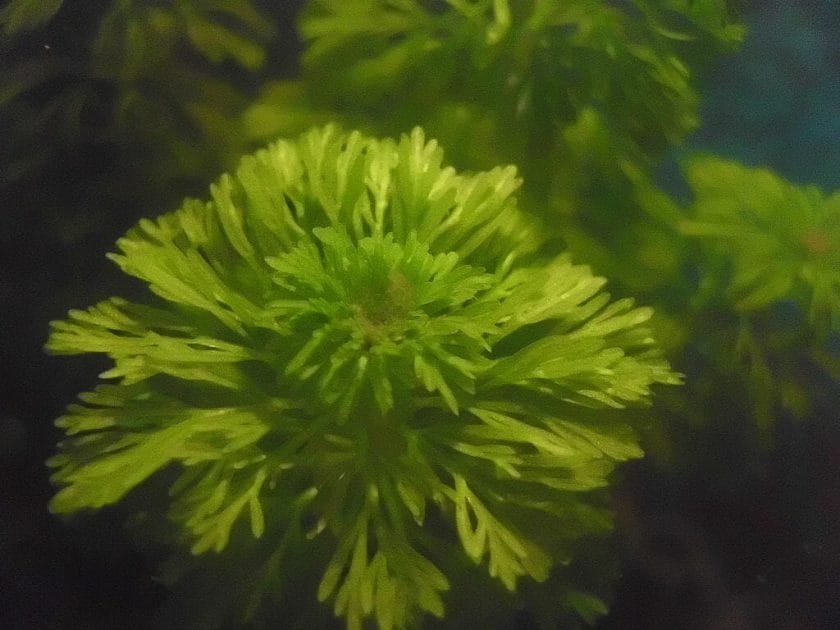
Photo by Andreus Felipen under CC BY-SA 3.0
| PARAMETERS | VALUES |
|---|---|
| PLANT | Asian ambulia |
| COMMON NAMES | Dwarf ambulia, Ambulis, Asian marshweed |
| SCIENTIFIC NAME | Limnophila sessiliflora |
| FAMILY | Plantaginaceae |
| CARE LEVEL | Moderate |
| LIGHT REQUIREMENT | Low |
| GROWTH RATE | Fast |
| TEMPERATURE | 59-82° F |
| pH | 5 – 8 |
| HARDNESS | 2 – 21°dKH |
| PLACEMENT | Mid-Background |
| MAXIMUM SIZE | 15 inches |
| MINIMUM TANK SIZE | 10 gallon |
Asian ambulia is very undemanding making it an ideal choice for beginners.
When provided with an ideal environment, this plant can produce beautiful flowers in your fish tank.
As this plant can grow pretty tall, up to 15 inches, it is an ideal choice to keep in an angelfish tank.
Light requirements
Asian ambulia is not very demanding when it comes to light. So it will do just fine in a low-lighting environment of about 0.5 Watts per liter of your aquarium.
Placement in aquarium
As asian ambulia can grow fairly tall, up to 15 inches, depending on the size of your aquarium, you should put it in the middle ground or background of your tank.
Substrate requirements
This plant doesn’t have any specific requirements, so you can plant it in any substrate.
Fertilization requirements
This plant is very undemanding and can do just fine without any additional fertilizers.
10. Water lettuce
See more images at Amazon here
| PARAMETERS | VALUES |
|---|---|
| PLANT | Water Lettuce |
| SCIENTIFIC NAME | Pistia |
| FAMILY | Araceae |
| CARE LEVEL | Moderate |
| LIGHT REQUIREMENT | Moderate |
| GROWTH RATE | Moderate |
| TEMPERATURE | 70 to 80 °F |
| pH | 6.5-7.2 pH |
| HARDNESS | Soft to Moderately Hard |
| PLACEMENT | Water Surface |
| MAXIMUM SIZE | 10 inches |
| MINIMUM TANK SIZE | 10 gallon |
Water lettuce is a floating aquarium plant that you can put in your angelfish aquarium to create some shade and hiding places for your angelfish.
This plant is not very difficult to keep in an aquarium as long as you can create some humidity for it.
Light requirements
Ideally, you should provide a medium lighting environment for Water lettuce.
Placement in aquarium
Water lettuce is a floating plant, so you should keep it floating on the surface of your aquarium water.
Fertilization requirements
Water lettuce is very undemanding when it comes to fertilizers, and it can do just fine without any additional fertilization.
Where to buy online?
Check the latest price of this plant at Amazon.com here
11. Dwarf Sagittaria

Check the latest price of this plant at Amazon here
| PARAMETERS | VALUES |
|---|---|
| PLANT | Dwarf Sagittaria |
| SCIENTIFIC NAME | Sagittaria subulata |
| FAMILY | Alismataceae |
| CARE LEVEL | Easy |
| LIGHT REQUIREMENT | Moderate |
| GROWTH RATE | Fast |
| TEMPERATURE | 68-82°F |
| pH | 6-8 |
| HARDNESS | 3-12 |
| PLACEMENT | Mid-foreground |
| MAXIMUM SIZE | 12 Inches |
| MINIMUM TANK SIZE | 10 gallon |
Dwarf Sagittaria is a great choice for beginners because it is extremely hardy and it can tolerate a wide range of water parameters.
Light requirements
Dwarf Sagittaria is not very demanding when it comes to light, so ideally you should put it in a moderate lighting environment.
Under high lighting conditions, you will start to see a tinge of red on its leaves.
Placement in aquarium
This plant can grow fairly tall, up to 12 inches, so depending on the size of your aquarium, you should put it in the middle or foreground of your angelfish aquarium.
Substrate requirements
Dwarf Sagittaria is not very demanding when it comes to the substrate. So you can plant it in any substrate.
However, it will definitely benefit if you plant it in a nutrient-rich substrate that is specifically rich in iron and CO2.
Fertilization requirements
Dwarf Sagittaria can do just fine without any additional fertilizers.
However, it will do better if you supplement it with some additional fertilizers that are rich in iron in the form of root tabs.
Where to buy online
Buy this plant from Amazon here
12. Java moss
See more images at Amazon here
| PARAMETERS | VALUES |
|---|---|
| PLANT | Java moss |
| SCIENTIFIC NAME | Vesicularia dubyana |
| FAMILY | Hypnaceae |
| CARE LEVEL | Very easy |
| LIGHT REQUIREMENT | Low to Bright |
| GROWTH RATE | Fast |
| TEMPERATURE | 59-86°F |
| pH | 5.0 to 8.0 |
| HARDNESS | 60- 240 ppm |
| PLACEMENT | Foreground |
| MAXIMUM SIZE | 4 inches |
| MINIMUM TANK SIZE | 5 gallon |
Java moss is one of the most popular plants in the aquarium hobby.
This plant is specifically a great choice for your angelfish tank if you want to create some beautiful aquascapes in your tank.
As this is a very popular plant, you can easily find it online as well as at your local fish store.
It is extremely hardy and can tolerate a wide range of water parameters and lighting conditions, which makes it an ideal choice for beginners.
Light requirements
Java moss can do well in almost any lighting condition.
So, you can keep it in low to high light conditions.
However, you will notice some differences in its growth depending on the amount of light it is getting.
Under low lighting, it will not grow as compact as it would under a highlighting environment.
Placement in aquarium
There are several ways to keep Java moss in an aquarium.
The simplest way is to just let it float in your aquarium, and eventually, it will find its place in the aquarium.
A more common way to put it in an aquarium is by attaching it to any ornament or driftwood in your aquarium.
Besides, you can also use it as a carpet plant and spread it across the substrate of your angelfish tank.
Substrate requirements
Java moss doesn’t have any specific substrate requirements.
As mentioned earlier, you don’t even need to plant it in the substrate. You can just attach it to any ornament or driftwood or just keep it floating in your tank.
However, if you want to plant it, you can just put it on the substrate of your aquarium and use it as a carpet plant.
Fertilization requirements
This plant can do well without any additional fertilizers.
However, if you provide it with additional fertilizers, it will grow much faster and compact.
Where to buy Java moss
Check the latest price of this plant at Amazon.com here
13. Temple plant
See more images at Amazon here
| PARAMETERS | VALUES |
|---|---|
| PLANT | Giant Hygro |
| SCIENTIFIC NAME | Hygrophila corymbosa |
| FAMILY | Acanthaceae |
| CARE LEVEL | Easy |
| LIGHT REQUIREMENT | Medium |
| GROWTH RATE | Fast |
| TEMPERATURE | 72-84° F |
| pH | 6.0-7.5 |
| HARDNESS | 71.43 – 321.43 PPM |
| PLACEMENT | Background |
| MAXIMUM SIZE | 24 inches |
| MINIMUM TANK SIZE | 10 Gallons |
Temple plant can tolerate a wide range of water parameters, which makes it an ideal choice for beginners.
This plant can grow pretty tall, up to 24 inches, which makes it an ideal plant to keep in an angelfish tank.
Light requirements
Temple plant does well under moderate lighting conditions of anywhere between two to three Watts per gallon of your aquarium.
Placement in aquarium
As temple plant can grow pretty tall, up to 24 inches, you should keep it in the background of your tank.
Substrate requirements
Ideally, you should plant Temple plant in a fine gravel substrate.
Fertilization requirements
For proper growth and development, you should regularly supplement Temple plant with iron-rich fertilizers.
Where to buy Temple plant
Check the latest price of this plant at Amazon here
14. Cryptocoryne wendtii
Check more images at Amazon here
| PARAMETERS | VALUES |
|---|---|
| PLANT | Cryptocoryne Wendtii |
| COMMON NAMES | Wendt’s Cryptocoryne, water trumpet |
| SCIENTIFIC NAME | Cryptocoryne Wendtii |
| FAMILY | Araceae |
| CARE LEVEL | Easy |
| LIGHT REQUIREMENT | Low |
| GROWTH RATE | Medium |
| TEMPERATURE | 72-82° F |
| pH | 6.0-8.0 |
| HARDNESS | KH 3-8 |
| PLACEMENT | Background |
| MAXIMUM SIZE | 6 inches |
| MINIMUM TANK SIZE | 5 gallon |
Cryptocoryne wendtii is one of the most popular plants in the aquarium hobby.
And the reason behind that is that this plant comes in different color variations as well as leaf sizes.
Cryptocoryne wendtii comes in red, green, and brown colors. And it’s leaf size varies from 5 to 18 inches.
Its leaves can spread quite far, creating a jungle-like effect in your aquarium.
Besides, this plant is very easy to care for, making it an ideal choice for beginners.
Light requirements
Cryptocoryne wendtii can tolerate any lighting condition.
So you can keep it in low light as well as under high lighting conditions.
Substrate requirements
You can use any substrate to plant Cryptocoryne wendtii in your aquarium.
Placement in aquarium
This plant can grow fairly tall, up to 6 inches, so depending on the size of your aquarium, you should put it in the foreground or mid-ground of your tank.
Fertilization requirements
For better growth, you should supplement Cryptocoryne wendtii with additional fertilization.
You can supplement it with liquid fertilizers as well as root tabs.
Where to buy online
Buy this plant from Amazon here
15. Lace plant
See more images at Amazon here
| PARAMETERS | VALUES |
|---|---|
| PLANT | Lace Plant |
| COMMON NAMES | Madagascar laceleaf, lattice leaf, lace plant |
| SCIENTIFIC NAME | Aponogeton madagascariensis |
| FAMILY | Aponogetonaceae |
| CARE LEVEL | Moderate |
| LIGHT REQUIREMENT | Moderate-High |
| GROWTH RATE | Low-Moderate |
| TEMPERATURE | 72-82° F |
| pH | 6.0-7.0 |
| HARDNESS | KH 3-6 |
| PLACEMENT | Mid-ground |
| MAXIMUM SIZE | 20+ inches |
| MINIMUM TANK SIZE | 10 gallon |
Lace plant has a very distinctive net-like leaf structure.
This plant is difficult to care for. You should only keep it in your angelfish tank if you have prior experience with live aquarium plants.
Light requirements
This plant does well under moderate to high lighting conditions. So you should provide light between 3 to 5 Watts per gallon of your aquarium.
Placement in aquarium
This plant can grow fairly tall—more than 20 inches.
So you should keep it in the middle ground or background of your tank.
Substrate requirements
You can plant Lace plant in any substrate, whether that is sand, gravel, or a nutrient-rich substrate.
Fertilization requirements
For healthy and proper growth of Lace plant, ideally, you should supplement it with fertilizers that are specifically rich in iron as well as race elements.
Also, it will definitely benefit from additional CO2 injection.
Where to buy lace plant?
Check price on Amazon here
16. Moneywort
See more images at Amazon here
| PARAMETERS | VALUES |
|---|---|
| PLANT | Moneywort |
| COMMON NAMES | Moneywort |
| SCIENTIFIC NAME | Bacopa Monnieri |
| FAMILY | Scropulariacase |
| CARE LEVEL | Moderate |
| LIGHT REQUIREMENT | Moderate to High |
| GROWTH RATE | Moderate |
| TEMPERATURE | 72-82° F |
| pH | 6.5-7.5 |
| HARDNESS | KH 3-8 |
| PLACEMENT | Background |
| MAXIMUM SIZE | 12+ inches |
| MINIMUM TANK SIZE | 10 gallon |
Moneywort is a moderately hardy stem aquarium plant.
This plant can grow fairly tall, up to 12 inches, which makes it a good choice for an angelfish aquarium.
Light requirements
Moneywort does well under moderate lighting conditions.
So you should provide it with at least two watts of light per gallon of your aquarium.
Placement in aquarium
As Moneywort can grow fairly tall, up to 12 inches, depending on the size of your aquarium, you should keep it in the foreground or background.
Substrate requirements
You can plant Moneywort in any substrate.
However, it will definitely grow better and faster if you plant it in a nutrient-rich substrate.
Fertilization requirements
For improved and better growth, you should regularly supplement Moneywort with fertilizers.
And you can use liquid fertilizers as well as root tabs for it.
Where to buy Moneywort?
Check the latest price of this plant at Amazon here
17. Corkscrew Vallisneria
Check more images at Amazon here
| PARAMETERS | VALUES |
|---|---|
| PLANT | Corkscrew Vallisneria |
| COMMON NAMES | Corkscrew Val |
| SCIENTIFIC NAME | Vallisneria torta |
| FAMILY | Tapegrass |
| CARE LEVEL | Easy |
| LIGHT REQUIREMENT | Moderate to High |
| GROWTH RATE | Fast |
| TEMPERATURE | 68-82.5 °F |
| pH | 5-8 |
| HARDNESS | Hard water |
| PLACEMENT | Background |
| MAXIMUM SIZE | 20 inches |
| MINIMUM TANK SIZE | 5 gallon |
Corkscrew Vallisneria is a seagrass like plant.
This is an easy to care for aquarium plant, which makes it an ideal choice for beginners.
Light requirements
Corkscrew Vallisneria can do well under moderate to highlighting conditions.
Under high lighting conditions, it will grow much faster.
Placement in aquarium
Corkscrew Vallisneria can grow up to 20 inches tall. However, it will take a long time for it to grow up to that height.
So you should keep it in the foreground or middle ground of your angelfish tank.
Substrate requirements
Corkscrew Vallisneria can grow in almost any substrate.
However, if you plant it in a nutrient-rich substrate, it will definitely benefit from it and grow much faster and better.
Fertilization requirements
This plant will benefit from some additional fertilizers.
So you should supplement it with fertilizer in the form of root tabs.
Where to buy online
Buy this plant from Amazon here
How to set up an angelfish planted tank
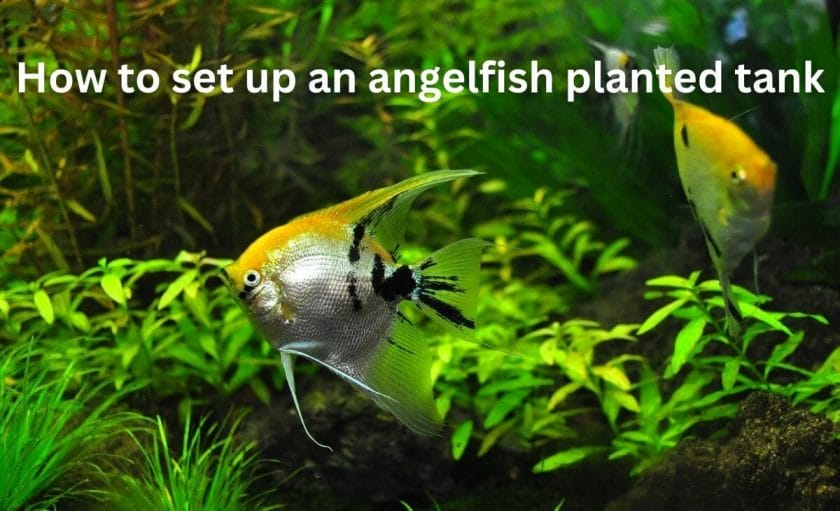
In this section, I am going to tell you how you can go about setting up a planted tank for your angelfish.
Fish tank
Angelfish can grow pretty tall. They can grow up to 8 to 12 inches tall.
That’s why they need a taller aquarium.
So your angelfish tank should be at least 30 inches tall; the taller, the better.
Aquarium substrate
Angelfish like tall growing aquarium plants because, in their natural habitat, there are a lot of tall growing aquarium plants.
Besides, angelfish live in areas where there is a lot of vegetation.
So you should emulate the same, and your angelfish tank should be very densely planted.
So in a nutshell, angelfish need tall, fast growing aquarium plants.
And for the plants to grow faster, ideally you should plant them in a nutrient-rich substrate.
So for your planted Angel fish tank, you should use a nutrient-rich substrate.
After choosing the substrate, when it comes to setting up the planted angelfish tank, first of all, you should add the substrate to the tank.
Driftwood and rocks
To give your aquarium a natural look and to emulate the natural habitat of angelfish, you should add some aquarium-safe rocks and natural driftwood in your aquarium.
And generally, you should choose taller rocks and driftwood with long branches.
And you should put them in your angel fish tank after adding in the soil or substrate.
Planting aquarium plants
In nature, angelfish live in a tropical environment so you should choose plants that can do well in a tropical climate to plant in your aquarium.
Besides, as mentioned earlier, an angelfish planted tank should be densely planted.
So your angelfish tank should have different types of plants. It should also contain plants of various sizes.
In the foreground, you should plant short aquarium plants.
In the middle ground, you should plant aquarium plants that can grow up to 10 to 12 inches tall.
And in the background of the tank, you should plant aquarium plants that can grow more than 20 inches tall.
Setting up all the equipment
Now you should set up all the equipment in your fish tank, such as heater, aquarium filter, aquarium light, thermometer, etc.
Tip on choosing an aquarium filterNaturally, angelfish are found in slow-moving rivers. So you should emulate the same, and your aquarium should not have any strong water current, which is usually produced by a filter.If your aquarium has a strong water current, as Angelfish are tall-bodied, it will be uncomfortable for them to swim around in the tank.So while choosing an aquarium filter for your planted Angelfish tank, you should make sure to choose an aquarium filter that doesn't produce a strong water current.You can choose a hang-on-the-back filter or a sponge filter because these filters don't produce strong water currents.
Add water
After setting up all the equipment, it’s time to add water to your angelfish planted tank.
Just make sure to dechlorinate your aquarium water before adding it to the tank.
How to switch from plastic aquarium plants to live aquarium plants
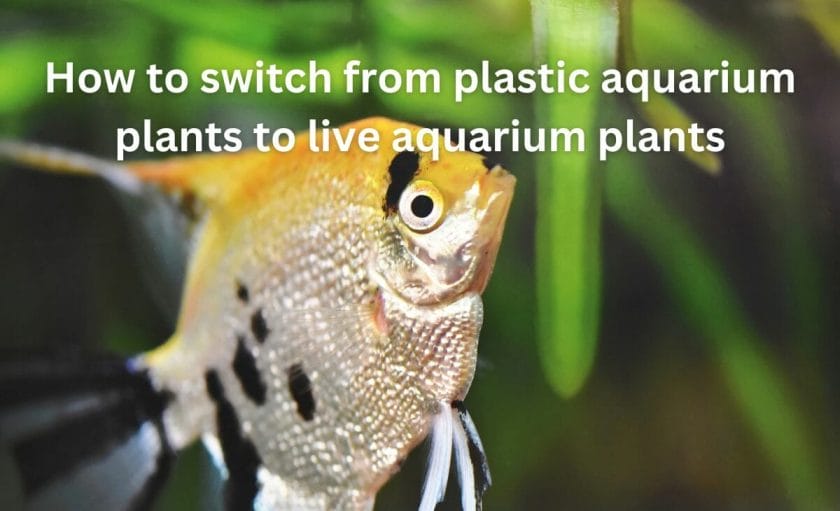
There are a lot of benefits of having live aquarium plants in an aquarium compared to plastic aquarium plants.
If you already have some plastic aquarium plants in your angelfish tank, switching from plastic to live aquarium plants can be a simple or complicated process, depending on the live aquarium plants you want to plant in your angelfish tank.
Heavy root feeder aquarium plants
If you want to plant heavy root feeder aquarium plants in your angelfish tank, then ideally you should plant such plants in a nutrient-rich substrate. In this case, you will need to replace your existing substrate with a nutrient-rich substrate.
However, there are many options available for live aquarium plants that will thrive in any substrate, whether sand or gravel, if nutrients are provided by inserting root tabs into the substrate.
Floating aquarium plants
Switching from plastic aquarium plants to floating aquarium plants is a very straightforward process.
You will just need to remove the plastic plants from your aquarium and put the floating plants on the surface of the water of your aquarium. That’s it.
How to take care of live aquarium plants in your angelfish tank
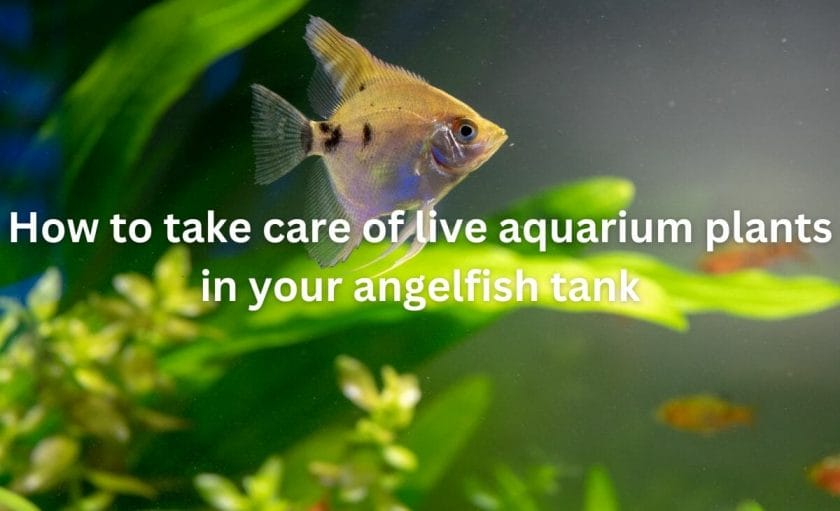
Live aquarium plants need a little care to do well in your angelfish tank.
Below are some of the essential things that you should keep in mind and provide for them to thrive in your tank.
Aquarium light
Plants need light for photosynthesis. Photosynthesis is the process by which plants create their own food.
So you should do research on the plants you are keeping in your tank and make sure that you are providing them with sufficient light.
Ideal water parameters
Generally speaking, plants are very forgiving when it comes to water parameters, but at the same time, they do need water parameters within the ideal range that they can tolerate.
That’s why, when choosing plants for your angelfish tank, you should make sure that the water conditions that the plants need match the water conditions that your angelfish need.
This way, both your angelfish and the plant can thrive in the same tank.
Nutrients
For the plants to do well, you will need to provide them with the nutrients that they need to grow.
These nutrients involve CO2, iron, and trace elements.
If you are planting heavy root feeder aquarium plants in your tank, then you should provide these nutrients through root tabs.
On the other hand, if you are keeping live aquarium plants that absorb nutrients through their leaves, you should provide them with nutrients using liquid fertilizer.
What are the best floating aquarium plants for angelfish?
Below are the best floating aquarium plants that you can keep in your angelfish tank.
- Water lettuce
- Hornwort
- Java moss
What are easy plants to keep in an Angelfish tank?
Below is a list of easy aquarium plants you can keep in your angelfish tank:
- Red tiger lotus
- Asian ambulia
- Dwarf sagittaria
- Temple plant
- Cryptocoryne wendtii
- Corkscrew vallisneria
- Java moss
- Hornwort
- Anubias
- Amazon sword
FAQ
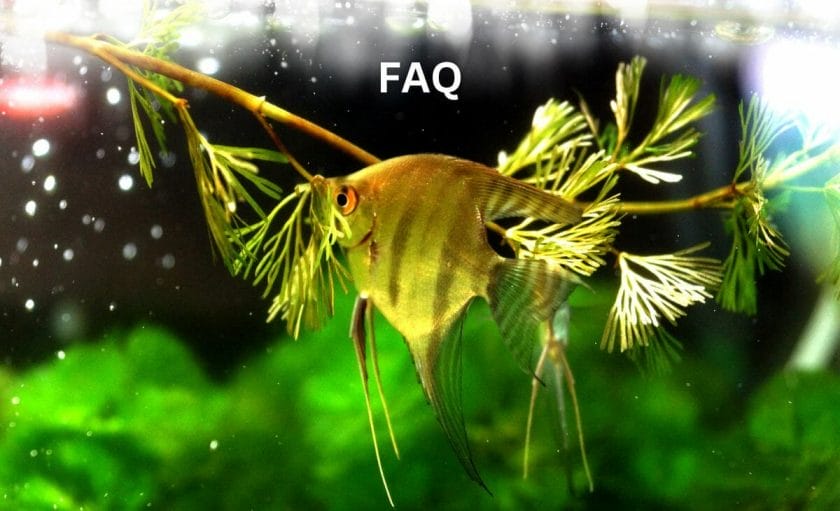
As angelfish like to forage for food near the bottom of the tank, you should make sure that the substrate doesn’t have any sharp edges.
Ideally, you should choose sand substrate, or if you want to have gravel, then you should make sure that it has rounded edges and not any sharp edges.
Besides, if you are planning to plant a lot of aquarium plants that absorb nutrients through their roots, you should choose a nutrient-rich substrate for your planted angelfish tank.
Angelfish like to nibble on plants. But it is very unlikely that angelfish eat the whole plant. Though angelfish are omnivorous, they mostly like to eat meaty foods. So again, it is very unlikely that your angelfish will consume the entire plant.
Angelfish like to munch on plants sometimes, so your angelfish may eat duckweed. And you don’t need to worry about it because it is completely safe for them to eat duckweed.
Angelfish are native to the Amazon River where there is a lot of vegetation.
That’s why your angelfish will appreciate a heavily planted tank.
When it comes to choosing the best tank decor for your angelfish tank, you should try to emulate the natural habitat of the angelfish.
In the natural habitat of angelfish, there is a lot of vegetation, so you should do the same and plant a lot of live aquarium plants in your angelfish tank.
Besides, to give an even more natural look to your angelfish tank, you should add driftwood, which has long branches.
Angelfish like the water parameters within the ideal range in the tank.
Besides, as angelfish come from the Amazon basin, where there is a lot of vegetation they also like heavily planted tanks.
Also, angelfish like peaceful tankmates in their tank.
I have written a detailed article on this topic, which you can read here.
Java mass is a great plant to plant in your angelfish tank because, with it, you can create beautiful aquascapes.
Especially in the case of an Angelfish tank, you can attach it to natural driftwood to mimic the natural habitat of your angelfish.
Angelfish like to hide under covers to feel secure if they are threatened for any reason. And fake aquarium plants can help you create such covers for your angelfish.
Besides, as Angelfish come from the Amazon basin, where there is a lot of vegetation, they like to swim through plants, and you can emulate the same with fake aquarium plants.
So if you don’t have any plants in your tank, then ideally you should keep at least some fake plants in your angelfish tank.
Angelfish sometimes like to nibble on plants. But it is very unlikely that they will damage the plants or eat them entirely.
Duckweed is a good plant to keep in an angelfish tank because angelfish sometimes like to nibble on it.
Besides, duckweed can grow pretty fast, so it will absorb a lot of toxins like nitrates from your angelfish tank.
Conclusion
So these are the best aquarium plants for your angelfish tank.
I hope you found this article helpful.
If you do, please share it.
As always happy fish keeping!
Related Articles:














